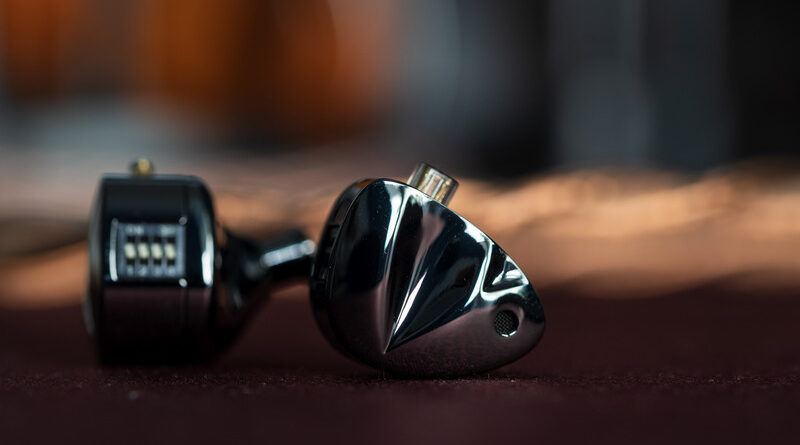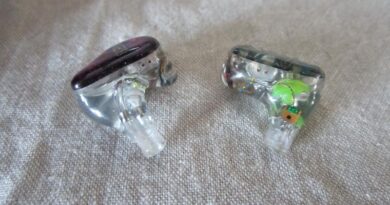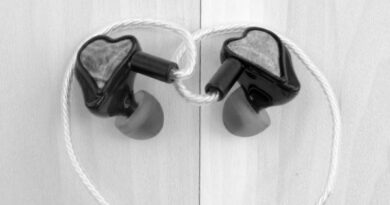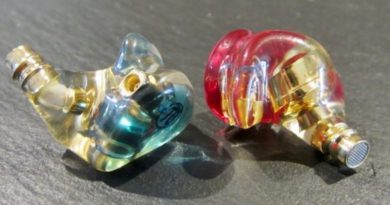KZ D-Fi Review – Switcheroo
Pros — Exceptionally well-built
– Switch-based tuning works well
– Sub-bass rumble
– Solid macrodynamic punch
– Stock accessories good enough to get you going
– A welcome departure from KZ house-sound
Cons — Mid-bass texture on the KZ D-Fi is lacking
– Upper-midrange glare
– Fairly strong mid-treble peak can get fatiguing
– Upper-treble extension is lacking
– Staging is average
In this Article
INTRODUCTION
It’s been a while since I have last reviewed a pair of KZ IEMs. Almost three years, to be exact. I missed out on quite a few KZ models in that period but from a tuning perspective, they were mostly more of the same.
However, around the end of 2022, KZ began to churn out some interesting models in terms of tuning. That departure comes full-circle with the KZ D-Fi, which is aptly named in the sense that the tuning “defies” the typical KZ house-sound (V-shaped, in other words).
Now, this is not a radical departure for KZ and some of their “signature” sound characteristics still seep through the cracks. However, the 4-way switch is a novelty in the budget segment, and the dynamic driver promises performance beyond the price point.
That’s a promise I hear often, but very few manage to keep it. Can the D-Fi be the one to follow through?
Note: the ratings given will be subjective to the price tier. KZ provided the D-Fi for evaluation.
Sources used: Questyle CMA Twelve Master
Price, while reviewed: $33. Can be bought from KZ’s official store.
PHYSICAL THINGS AND USABILITY
PACKAGING AND ACCESSORIES
KZ rarely focuses on the packaging and presentation and in the budget segment I applaud this move. I do wish that less plastic was used in the packaging for environmental reasons.
The stock accessories are good enough to get you going. The stock cable is an SPC affair that gets the job done. Stock tips are decent but tip-rolling may help in controlling the bass, for example.
BUILD QUALITY
Phenomenal, in one word. The metal shell is dense and I find the face-plate visually appealing. The review unit is the one with the tuning switches and I recommend getting this one because the price premium is absolutely worth it.
The switches are somewhat fiddly to operate with the fingernails, so KZ supplies a SIM-card tool to make the task easier. There is one vent on the face-plate and one on the inner-side of the IEMs. The 2-pin ports stick out of the shell – a choice I am not a fan of, but it is what it is.
COMFORT, ISOLATION, AND FIT
While the shells are shaped ergonomically, the added weight can be a bit of a bother for long listening sessions. Other than that, no qualms with the comfort. Isolation is above-average and becomes drastically better with foam tips.
SOURCE AND EARTIPS
The D-Fi are very easy to drive and on my desktop Questyle CMA Twelve Master, I “over-drove” them when using standard gain, so I had to use low gain while testing them.
DRIVER SETUP
KZ D-Fi have a 10mm single dynamic driver with the usual “dual-cavity”, “dual magnetic circuit” bonanzas. The driver performs well for the price, but the most interesting part for me is the Zobel network-based crossover-circuit. I do not recall seeing such tuning methods in any of the IEMs in the past… decade?
From what I can gather, the Zobel network is used to “attenuate” the frequencies by approx. 5 dB. When all the switches are down (default position), the entire FR remains same but things go “quieter”. Flicking each of the first three switches (in conjunction with the other one) adds 1dB of sub-bass boost from 50Hz downward.
When all four switches are engaged, the networks does not attenuate the frequencies anymore and you get a noticeable increase in loudness. A clever mechanism indeed. Keeping only switch four engaged, meanwhile, increases the loudness of the treble region by a couple dBs.
TONALITY AND TECHNICALITIES
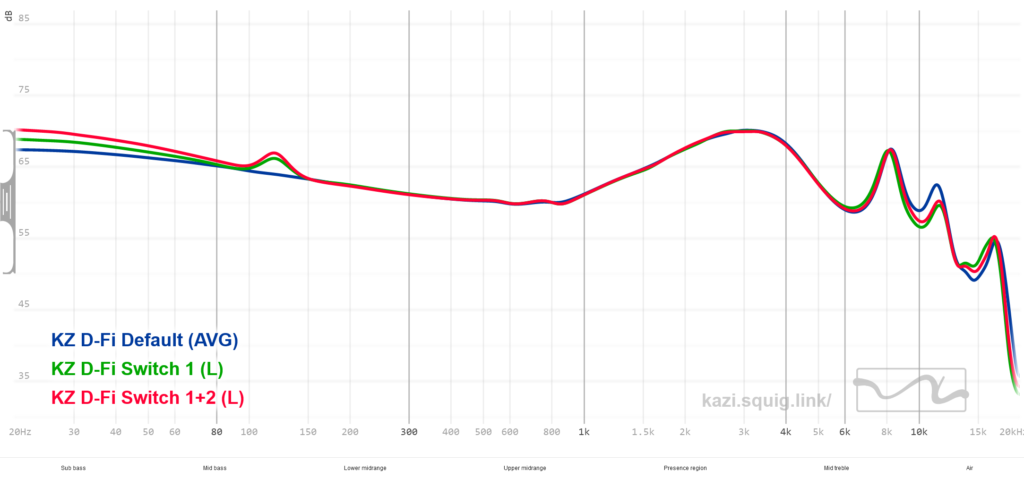
KZ D-Fi have an upper-midrange forward tuning. The lower-mids still sound recessed but the focus on the upper-midrange is what you notice the most. The overall tuning is rather energetic.
Sub-bass rumble is strong and noticeable even around 25Hz. Mid-bass texture is lacking though, so snare hits do not quite have the timbral characteristics you’d expect.
The mids are affected by the upper-midrange glare. It does not seem too much at the graph at first, but the upper-mids can get intense in soaring female vocals or while playing certain guitar riffs. As a side-effect, male vocals can sound somewhat “hollow” in some tracks.
Upper treble lacks airiness. Treble is mostly there due to a noticeable 8kHz peak. Then the treble rolls off past 13kHz or so. Given the budget nature, I think this performance is acceptable despite the hit on perceived “resolution”.
Despite the treble roll-off, initially, there is some “wow factor” due to the hyper-energetic tuning. Things can get fatiguing though if you are sensitive to boosted upper-mids.
Stage is narrow. Imaging is good for the price though some of the peers do it better. Macrodynamic punch is strong, while mIcrodynamics are lacking.
SELECT COMPARISONS
It’s a bit difficult to make “Apples vs Apples” comparisons when it comes to the D-Fi because, let’s face it – there isn’t another option in this price range that has tuning switches.
Putting the novelty aside and only focusing on the sound quality, Final E1000 are better tuned across the board, even though they lack the bass rumble of the D-Fi, and the build is nowhere near as reassuring.
The BLON BL-05S, meanwhile, have a gaudy color scheme that hides the overall great sound, which is better than the D-Fi in terms of tonality and technicalities. They need changing the cable and tips, however, and the price tag can go well beyond USD$50 after that fact.
CONCLUDING REMARKS
KZ D-Fi are the odd ones out in the budget segment. The tuning is closer to the current “trends” of boosting the upper-midrange and dialing down the bass, while the tuning switches can be novel enough for many to warrant a purchase. I am not a fan of the shoutiness, nor the lack of mid-bass texture and warmth. Then again, the pricing is fairly competitive.
I do wish KZ further tones down the upper-mids in the next release, and perhaps focus on making the sound slightly warmer and more inviting. Once that happens, I may finally have found a pair of KZ IEMs that can stay in the collection for future comparisons.
DISCLAIMER
Get it from KZ Official Store
Our generic standard disclaimer.
PHOTOGRAPHY
You find an INDEX of our most relevant technical articles HERE.



